Almost fifty years ago in my late teens I discovered that the world was doomed and that an awful apocalypse was just around the corner. I learned this by reading books like ‘The Population Bomb’ by Professor Paul Ehrlich which predicted worldwide famine in the 1970s and 1980s due to overpopulation, and ‘The Doomsday Book’ by Gordon Rattray Taylor which said we faced a planetary environmental disaster that would within a couple of decades cost the lives of hundreds of millions of people and lead to the collapse of our civilisation. Both books used apparently impeccable logic, data and evidence and I was utterly convinced, and one of the reasons back then that I wanted to overthrow capitalism was to save the planet. I continued to believed that planetary doom was looming for the next couple of decades. This belief was nurtured by reading newspapers like the Guardian which seemed to be reporting an increasing number of looming apocalypses including, in 1974, that a ‘new ice age was coming fast’.
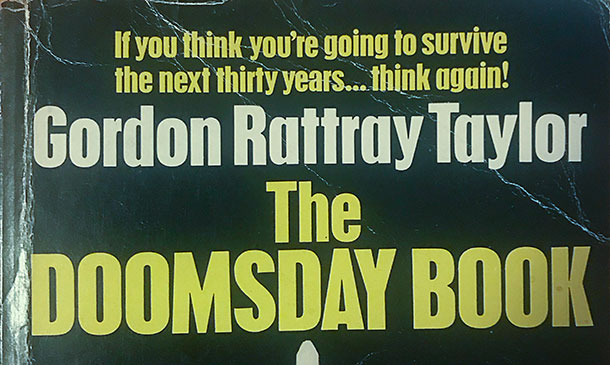
The book that told me nobody would survive the next thirty years – it was published in 1970
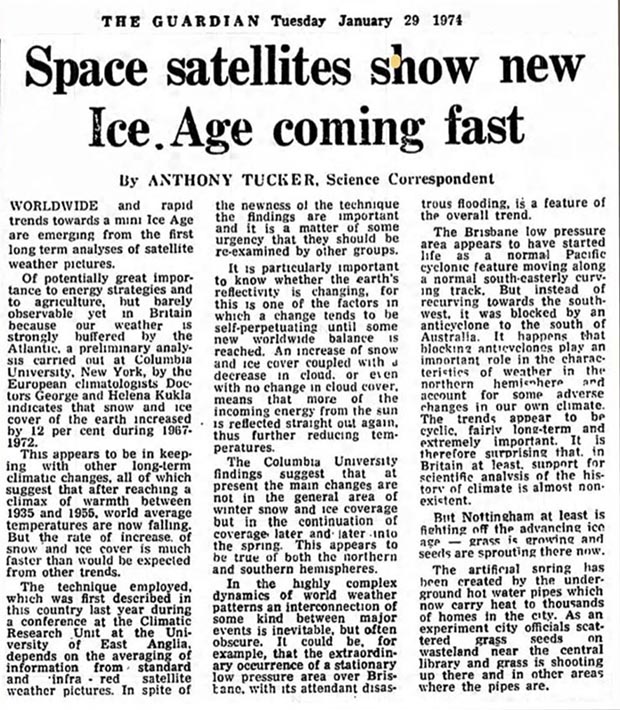
The Guardian January 29th 1974
Five decades later I am a grandfather, there has been no global environmental collapse, there were no planetary famines, civilisation has not collapsed and in fact using numerous and common sense metrics it is clear that globally human welfare has hugely improved since 1970. And yet on almost any day if I read any of the organs of liberal opinion like the Guardian, or the press releases of environmental NGOs, I can see endlessly repeated claims that we are facing planetary doom in just a few years. Now its not a looming ice age that the Guardian is warning about but the apparently terrible threat of Global Warming. The Guardian told me in 2008 that we only had 100 months to avert global disaster, by 2009 the newspaper was reporting that we only had four years to save Earth, and in 2018 it told me we only have 12 years to limit climate change catastrophe. We are always just a few years from the apocalypse.
Some time in the late 1980s, around the time that the forests weren’t dying from acid rain, I began to realise that none of these apocalyptic environmental scare stories ever came true, and that the environmental movement, and the newish Green parties which were it’s political arm, were absolutely addicted to doom mongering. I could see that there were definitely specific, often urgent, environmental problems all of which could be fixed, albeit with the the right level of political support and money, and that it was helpful that campaigning organisations worked to get these problems fixed. But I couldn’t see doom looming, and I couldn’t see any environmental problem that required a radical, total and global rebooting of our civilisation. I could see that the Green’s were addicted to hyping up every environmental problem into some sort of existential threat to frighten people into supporting what they thought were worthwhile causes but I thought it was a dangerous addiction because Green doom mongering seemed to actively, and enthusiastically, promote non-rational political discourse. Worse – big chunks of the Left were beginning to lap up this sort of Green doom nonsense and in doing so were, without realising it, beginning to drift a long way from what should be the real priorities of progressives.
Politics and governance is largely about deciding priorities. We can’t fix everything at once. What urgent problems should be solved first? What problems can wait a bit longer for a solution? What should we spend our public money on right now and who should pay for what? Having been involved professionally in the political system I am aware of a basic truism of democratic civil society which is that no pressure group or campaigning NGO is ever interested in, or even capable of, balancing it’s needs against the needs of others. No disability charity or campaign ever says ‘that’s enough money for the disabled, time to spend the money on something else’, no community group ever says ‘that’s enough money for our community, time to spend the money on another community’. Campaigning NGOs and pressure groups all claim that their cause should take absolute priority and they collect evidence, lobby and argue on that basis.
Environmental campaigners are just the same. According to them all environmental problems are dire, are almost always getting worse, and are going to lead to catastrophic trouble any day soon, and thus they argue that the environment is by far the the most important political issue. Environmental campaigners, and the Greens, do however differ from other sorts of pressure groups in that their cause is presented as being so all encompassing and so urgent (‘we are trying to save the entire planet!’, ‘the life of all our children depends on this!”) that they believe that their cause is about averting a global catastrophe, and so they seek to permanently trump all other priorities, and all other political causes. The environmental/Green movement see it’s cause as so total that it seeks the profound transformation of society, the economy and all aspects of how we live and thus has become a new sort of general political movement competing for support, idealogical allegiance, votes and power with other generalist currents of political thought. The Green movement doesn’t just want to push its cause to the top of the political ‘To Do’ list, it wants to permanently seize control of all politics and government in order to radically remake the world according to its agenda.
Over the last thirty years or so large parts of the radical Left have fused with the Green movement. The reasons for this are pretty clear, and its partly the same reason I was a supporter of extreme environmentalism back in 1970, which is that it is easy to condemn profit making capitalism if you can blame it for endless environmental disasters, and using environmental problems is a relatively easy way to scare people (especially middle class people) and thus attract them to the cause of anti-capitalism. The other thing that attracted the Left to environmental critiques of capitalism was that environmental problems are usually transnational and their solutions often require actions that transcend the limits of what just national governments can deliver. This fits really well with the radical Left’s long standing desire to move politics beyond nation states and to foster international movements, cooperation, and institutions. However the adoption by the Left of the environmentalist claims of looming doom took on a special urgency and engagement after 1989. For most of the 20th century the radical Marxist left had claimed that capitalism was digging its own grave, that its internal contradictions (specifically the contradiction between the forces and relations of production) would one day bring it all tumbling down. This belief that history was on their side, a belief I held well in to my early middle age, meant that radical leftists could weather any storm, survive any set back by believing that one day capitalism would collapse. The problem was that it didn’t collapse, and worse it was the non-capitalist systems that collapsed in 1989-1992, or in places like China and Vietnam, morphed into dynamic capitalism. This meant a key pillar of leftism, the belief that the end of capitalism was inevitable, had evaporated, and even worse in the two decades after the collapse of communism it was capitalism that surged globally with huge new energy. It was during this period, the decades after the fall of communism when there seemed no alternative to rampant capitalism, that the radical Left began to really merge with the Greens, and began to enthusiastically adopt the Green’s long standing addiction to doomsday environmental catastrophism. Capitalism couldn’t be eternal because it was going to destroy the planet! With that position the Left’s belief in capitalism’s inevitable collapse, along side its desire for absolute moral superiority, was triumphantly reborn.
The Green movement, increasingly added and abetted by the radical Left, has been enormously successful in the last three decades in establishing its ideology as the new common sense, and, as we know from Gramsci, seizing control of common sense is a tremendously important part of securing political hegemony. ‘Being Green’ is now the equivalent of ‘Being Good’. Everybody wants to be Green, corporations, political parties, public bureaucracies, media organisations, film stars, universities, teachers, etc. This hegemony of Green common sense means that the message that we face some sort of global environmental catastrophe, that the planet needs saving, is so incredibly pervasive that for anybody from the progressive and left wing of politics to interrogate such claims critically or sceptically is seen as being perverse. As the Left has gravitated ever more strongly towards Green ideology so parts of the radical Right has moved to become the most vocal bastion of Green scepticism, and as a result a self reinforcing polarisation has been created. Now, for example, belief and scepticism about dangerous human made global warming are powerful markers for where one lies on the political spectrum. Bizarre.
One result of this powerful embedding of Green ideology in so many social institutions is that the normal processes where by extraordinary claims of doom should be scrutinised and tested, no longer work, instead we have a feedback loop that accepts virtually any claim of looming environmental doom at face value and as fact, and then amplifies them. The mass media already has a much greater appetite for bad news than good news and the environmental teams of most of the major liberal news outlets (for example the Guardian and the BBC) are now wholly made up of true believers in the Green ideology so almost no sceptical interrogation of an environmental scare story is undertaken by the liberal media or by anyone from the Left or progressive wing of politics.
The media’s addiction to scare stories and bad news means a story like ‘global forest coverage has grown significantly over the last fifty years’ (which is true by the way) will get almost zero coverage compared to say an episode of unusually large forest fires occurring somewhere which will be punted as a portent of doom (more on this below). The result is that almost any environmental scare story or press release that crosses the desks of media companies will be run, unqualified, unscrutinised and unchecked, usually under a nice pithy scary headline. Even worse is the fact that critiques of research promoting environmental alarm, exposing their flaws or debunking their apocalyptic conclusions, are almost never publicised or even noted. Only the bad news lives on.
Alongside the media there are numerous large green NGO’s and large bureaucratic organisations such as the UN’s Intergovernmental Panel on Climate Change (IPCC) who will pick up, echo, recycle and promote any environmental scare story. As Georges Clemenceau said “There is no passion like that of a functionary for his function” and no bureaucracy is ever going to argue for its own abolition or that it’s function is unnecessary or unimportant. Globally Green NGOs now have budgets in the hundred of millions and a full time staff apparatus in the tens of thousands and activist supporters in the hundred of thousands, all engaged in constant campaigning and advocacy, none of them are ever going to argue that an environmental problem is not that important, that issues other than the environment should take priority, or that an environmental scare story is over blown. The UN’s Intergovernmental Panel on Climate Change (IPCC) for example does not have as its a core mission statement the investigation of climate change in general but rather the investigation of human caused climate change, so it’s never going to announce that human caused climate change is not that important and that as a result its budget and staff should be reduced.
This global appetite for bad news about the environment, and the permanent standing army of bad new promoters such as the green NGOS, actually skews research priorities. Prioritising the investigation of environmental problems and the effects of climate change are now written into the research priorities for major funders (the EU is a good example). Academics know that promoting their particular specialist field of research as pertaining to environmental problems, especially climate change, will greatly increase their chance of securing both funding and attention for their work. Often the press release marking the publication of a piece of research showing an environmental problem will hype up the research findings (a press release is after all intended to get media attention and can be significantly free of the usual academic caveats). So if you want to be funded for research into the distribution of Red Squirrel populations, and if you want your results noticed, you write it up as including conclusions about the alarming impact of climate change on Red Squirrel populations. The inverse is also true if you want to endanger your academic career and your research funding then challenging the green consensus is a very good way to do it. The recent case involving the legal action by Professor Peter Ridd who has been a faculty member of James Cook University in Australia for thirty years studying coral reefs and who was sacked for saying that the alarmist research produced by his colleagues claiming that the coral reefs were dying was shoddy and incorrect (research which coincidentally was being used by the university in its application for huge sums of research funding) is an example of the sort of career damage you can incur by breaking the green consensus. As long as their executive summaries and abstracts are in accordance with the zeitgeist that says there is a terrible human-impact for which we must all be sorry, the scientists can be reasonable confident that they will get a lot of attention and will increase their chances securing further funding.
A key supporting argument for the lack of scepticism about green doom stories is the claim that such stories are supported by scientists. In the case of climate change alarm the claim is that 95% of scientists support the idea that humans are causing dangerous climate change. There’s a lot to unpack here, not least an exploration of the absurdities of the 95% claim (something I hope to explore in a lot more detail in a future article). But an absolutely key point is that the mere fact that scientists support an environmental scare story does not mean normal standards of scepticism or inquisitiveness about the evidence should be suspended. Scientists once said that black people were genetically inferior and women were less rational than men, those examples of ‘settled science’ were challenged and over turned by healthy progressive scepticism which was willing to interrogate strongly entrenched incumbent scientific theories and ideas. If some scientists claim, as some now do, that the Left should pivot from prioritising meeting the energy needs of the billion people who – in the 21st century – are still living in grinding poverty without electricity, and instead prioritise reducing fossil fuel use then surely it is necessary for progressives to rigorously challenge and test that assertion. Taking it at face value will simply not do.
The history of science is littered with many, many examples of scientists organising to block new theories and stubbornly support the existing ones even when the evidence for the incumbent theory was weak or problematic, and that happened with theories that had no political resonance and without a vast army of activists, bureaucrats and the media rubbishing sceptical scientists as ‘deniers’. Science has its own political economy, and scientists are concerned about career paths, funding, status and peer approval just like everybody else and rocking the boat can have dire career consequences. The reality of actual scientific practice in relation to environmental scares, and especially climate science, is that it is intensely political and idealogical. There are are now powerful social complexes made up of scientists ensconced in career paths, research funding regimes, powerful NGOs, extensive public bureaucracies and a gullible liberal media that will accept almost any scare story about the environment, and which denigrates scepticism as being right wing and renders the difficult process of balancing social and political priorities all but impossible. Are the social consequences of drastically reducing fossil fuel use (especially for the poorest people on out planet) worse than continuing to use fossil fuels to support economic growth and using the resulting wealth to adapt to a changing climate? Such a question is hardly explored by the left where the orthodox green position, which has opposed fossil fuel use for decades, is now more or less just accepted as given.
There is an argument I have come across that none of this matters, that exaggeration, or even lying, is justified for a good cause, and even if an environmental scare story is not true it doesn’t matter because scares stories help save the planet. I think such thinking is wrong and I think that the absence of healthy scepticism when it comes to Green scare stories is deeply damaging to the Left and to progressive politics.
The world is a complex place and changing it for the better is very difficult. Operating on the basis of false evidence, dealing with problems that are not real or utterly exaggerated is not a good way to be effective at making things better. Unpalatable truths and difficult balancing acts don’t go away just because people start shouting about the end of the world. Politics is about priorities. For example fossil fuels are the foundation upon which all of human material welfare is based and renewables are not going to replace them in the foreseeable future (they really aren’t) so how can you significantly reduce fossil fuel use whilst preserving material well being for those who have it and more importantly increasing material well being for those who are still poor? Just claiming that the planet is dying (especially if such claims are based on dodgy evidence and wild exaggeration) and insisting loudly that we must stop using fossil fuels answers none of the difficult and complex questions about what to do next. And if the Left can’t answer the questions about what to do next, then the Right will. This is especially true if the Left automatically colludes with the Green’s constantly crying wolf about non-existent or grossly exaggerated problems, all it does is make the Left seem out of touch and a bit bonkers.
I am writing this piece in order to persuade people, especially people on the Left, to be more sceptical about environmental scare stories. Greens don’t exercise sensible scepticism, the Left should. Being healthily sceptical means not accepting news stories about environmental problems at face value, especially if those problems are presented as being apocalyptic and/or they appear in organs of liberal opinion like the Guardian or BBC, and not accepting a news story just because it seems to agree with what you already believe. Always try to look at the details of the data and research methodologies behind the alarming headlines, use Google to look for the critiques that often appear rebutting or qualifying the scary research, because those rebuttals won’t be published in the Guardian and you will need to seek them out yourselves. Don’t be phased if you find counter arguments to scare stories that come from the Right, be open minded, be inquisitive, look at the evidence and make your own mind up.
A couple of recent examples of environmental scare stories where some healthy scepticism would not have gone amiss
Example one: “OMG the USA is burning up!”
A very important way that environmental scares are propagated is through the use of distorted or deliberately misleading charts, graphs and graphics. The authors of scare stories know that most readers won’t even read the actual story in much detail so a scary headline and some scary graphics are enough to convince a lot of people, especially if the graphic is produced by some public body and is reported by an apparently reputable organ of liberal opinion.
Choosing when to start or stop a time series graph is an easy way to mislead. A good example of this is the US Government’s National Climate Assessment (NCA) report that was released in the autumn of 2018 and whose very scary conclusions about the impact of global warming in the USA received very widespread media coverage. Like all the other liberal media the Guardian newspaper carried several stories about the NCA report including one on the 23rd of November 2018 entitled “Climate change ‘will inflict substantial damage on US lives'” which was illustrated by a photo of the recent Paradise wildfire in California. This article included the following: “The influence of climate change is being felt across the US with increases in disastrous wildfires in the west” and it smugly reports that “Trump has downplayed assertions by scientists and firefighters that climate change is making California more wildfire-prone, instead pointing to “gross mismanagement” of forest areas”.
The report is long and detailed and even journalists are unlikely to read much more than the Executive Summary and most of the news story were dependent on the often reproduced summary graphic below (click the image to download a full size version).
There is a lot of info in this single graphic and I could say a lot about it, about how the sea level change it shows is a few trivial inches a century and not accelerating, how there is no trend in droughts or how the growing season seems to have lengthened which is surely a good thing. What I want to concentrate on are the two graphs showing an apparently alarming increase in USA wildfires and heatwaves in recent decades and which are explicitly presented as evidence of the increasing impact of global warming in the USA. The recent deadly wildfires in California for example were heavily promoted by the media and the Greens as being a symptom of global warming and here is a government report that shows that wildfires seem to be on a relentlessly increasing trend. The actual report itself features a photo of a wildfire on its cover.
However if you look closely at the heatwave and wildfire charts you can see a telltale sign that something is not right: the US Heatwave charts start in the 1960s but we know that the US has extensive weather records going back a lot longer, and its the same with the wildfire chart which starts in 1980 but there are obviously wildfire record going back a lot longer (the US Forests Service was founded in 1878). So why were these recent dates chosen for these two graphs? The answer is that they were chosen in order to mislead, they were chosen so a false impression could be created that heatwaves and wildfires have all started to get a lot worse in the last few decades as a result of global warming.
Let’s look in detail at the way Fourth National Climate Assessment lies – and that is the only word you can use to describe deception this blatant – about about wildfires in the USA. The graph below was taken from page 38 of the Fourth National Climate Assessment document released in November 2018, it’s the same graph taken from the summary graphic which was reproduced in multiple news stories. It looks pretty conclusive, wildfires seem to be on a relentless upward curve and that must be the result of global warming. In the summary graphic wildfires are listed as a climate change indicator with an upward pointing arrow next to it. The message is very clear – but untruthful.
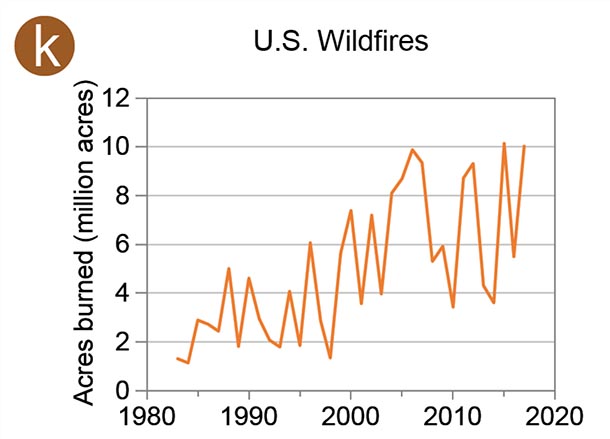
But why did they start their graph in 1983? The US has very detailed burn acreage data going back for more than a century compiled by the US Forest Service, and that data shows unequivocally that the areas burnt by wildfires in the US were much, much higher prior to 1970. The graph below is the official graph produced by the Forest Service of wildfire acreage burnt in the US going back to 1916 and as as you can see the area burnt by wildfires in the 1920s through to the 1940s was much higher, several times higher, than the decades since 1970. What the authors of the Fourth National Climate Assessment did was they hid almost all the data on the extent of wildfires in the past, data which actually shows that burn acreage is down by 80% in the US over the past 90 years.
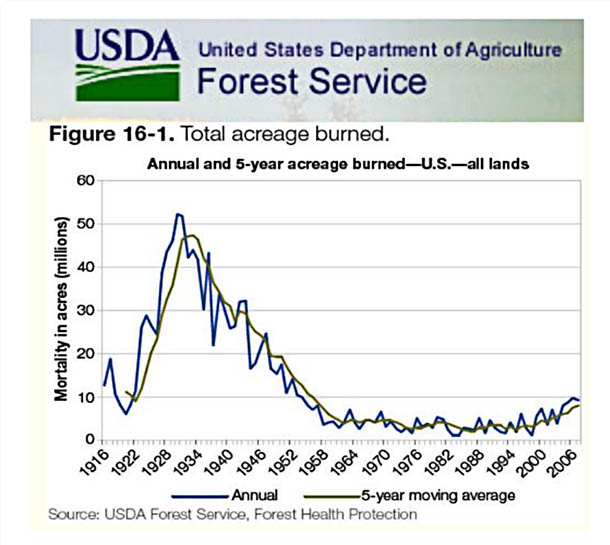
If you overlay the data about wildfires in the Fourth National Climate Assessment (marked in orange) on the Forest Service acreage chart you can see exactly what they are doing. They picked the lowest point for their start date so that they could show an upwards trend – and deceive the public.
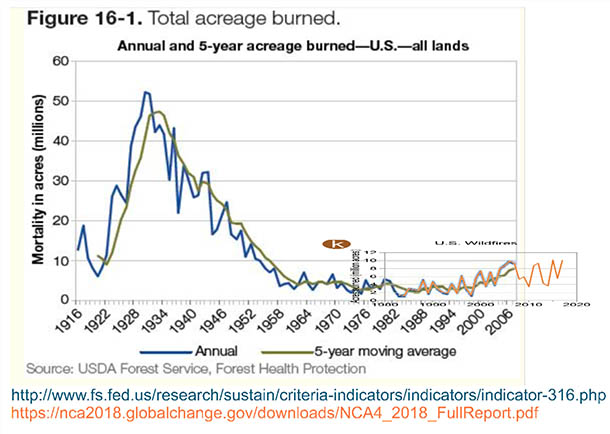
Even wildfires in California, the poster state for the promotion of links between wildfires and climate change, shows the same pattern: if you include all the data it shows that wildfires were much more extensive in California in the 1930s than now.
If you look at the data about US heatwaves and the way that it was presented in Fourth National Climate Assessment you see a similar act of what must be deliberate deception. Once again a graph is presented, shown below, of US heatwaves that shows a steady and steep increase in heatwaves in the US since 1960. This is once again presented as an indicator of climate change and is shown explicitly as such in the summary graphic.
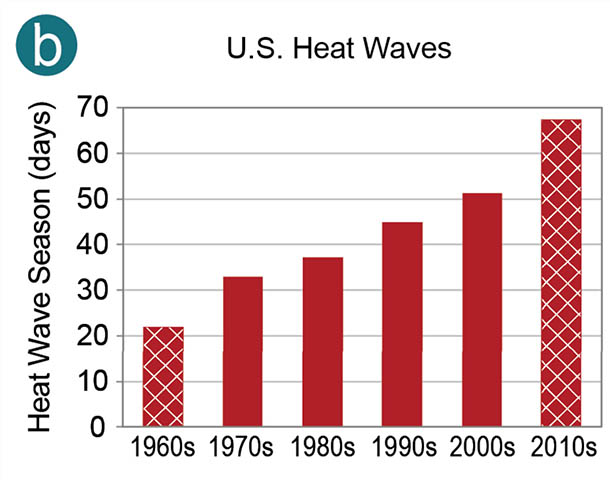
But why did they choose the 1960s for their start date? The US has excellent temperature records going back to the late 19th century, and in fact the 2017 National Climate Assessment showed heat wave data going back to 1900. The 2017 report contained data that showed unambiguously that US summers were much hotter prior to 1960, and that the 1960s and 1970s, the start point for the 2018 chart, had the fewest heatwaves of any period in the US. This very important data from before the 1960s was excluded from the 2018 report. This chart from an older climate assessment shows heatwaves were much hotter in the 1920s and 1930s, which is not surprising given that the 1930s (the decade of the Dust Bowl) was by far the hottest decade in the US in the last 120 years.

If you look at the data about the number of days considered to be heatwave days you get this chart – again the 1920s through to the 1940s had far more heatwave days.

These charts are completely consistent with the chart published by US Environmental Protection Agency of heatwave data. Here is the official EPA graph.

Here is the chart from the Fourth National Climate Assessment overlaid on the Environmental Protection Agency chart which shows very clearly what they are doing. The 2018 report cherry- picked the only start date in the graph which they could use to create the appearance of a warming trend. The reality is the exact opposite of what is claimed in the 2018 National Climate Assessment report. The frequency of hot days in the US was much higher in the 1930s compared to recent decades.
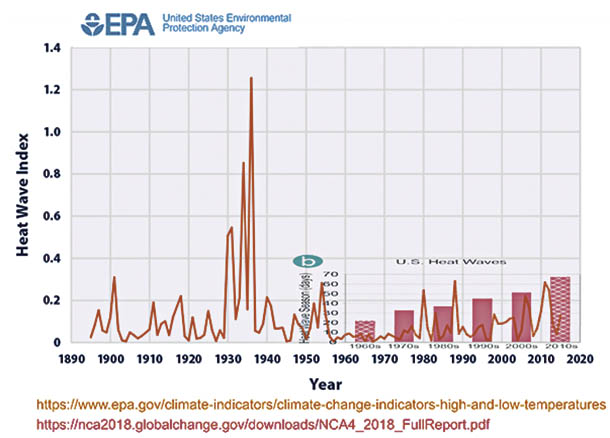
What’s so shocking about all this is not just that an important government report like this, one that will be widely believed and reported contains deliberate deceptions like this, that’s wrong and unforgivable, but what’s really revealing is that nobody exposed this cheap con job. The US Environmental Protection Agency, for example, compiles and publishes data about heatwaves going back to 1890 and they said not a word about the obvious deception in the National Climate Assessment. Similarly the US Forest Service has excellent data on wildfires going back to 1916 and they said not a word about the deceptive information about wildfires in the National Climate Assessment. None of the prestigious newspapers and magazines that reported the Climate Assessment’s conclusions bothered to check the data, data that was in the public domain and just a couple of clicks away via Google. Neither the UN’s IPCC (which is tasked with assessing human caused climate change) nor a single environmental NGO questioned the way the Climate Assessment misleadingly presented the heatwave and wildfire data. It’s like all the basic political and civil mechanisms that should help ensure that policy is based as far as possible on fact breaks down when it comes to Green scare stories and climate alarm.
Needless to say not a single voice from Left expressed any concern about the deception in the report. In fact I am sure nobody on the Left noticed the deception because all environmental scare stories are now accepted at face value and to undertake any sceptical investigation is viewed as being reactionary.
Example two: “OMG the insects are dying!”
Generally it’s important to be very sceptical of statistical data and methodology when it comes to Green scare stories. As Ronald Coase, an economist once said: “If you torture the data long enough, it will confess”. Scare stories are often based on the result of some new research paper, and most environmental related research papers usually rely on interpreting and processing data sets. The sorts of statistical techniques used, and the source and quality of the underlying data, are all critical when it comes to judging whether a paper’s conclusions are sound but understanding the statistical processes involved can be fiendishly complicated. In reality lots of research papers skirt over caveats, uncertainties and complexities in their research techniques when writing up executive summaries and their conclusions often contain strong, bold and alarming conclusions. Most journalist won’t read the actual research paper, and anyway they lack the skills to interpret them, and almost all newspaper reports use the bold and scary conclusions, usually simplifying them even more, turning them into scary headlines. The result are the scary newspaper headlines we see all the time, and and these headlines are endlessly recirculated as campaigning slogans by the Greens. It is very rare indeed that a newspaper bothers to ask independent experts to review a paper. Greens never do so and are ideologically precluded from doing so. And the critical reviews of scary research papers, detailing methodology weaknesses that often emerge in the weeks and months after the initial flurry of scare headlines and are almost never reported. All that remains is the scare story even when it based on deeply flawed research.
There is a special sort of of statistical study, secondary research, that is particularly dangerous, and it’s one that has been used to create some of the really big recent scare stories. It’s where researchers don’t gather any new data themselves directly but rather seek to amalgamate lots of different existing studies, or data sets, and claim to show a trend or conclusion. This sort of study involves taking lots of different data sources compiled in different ways, all using different methodologies and data sets, and somehow combining them to show a pattern. Because the source material, which consists of lots of other research papers or data sets, are all different, combining them in a way that shows a significant pattern or trend is very complex, and requires complex statistical processing. Which means it’s very easy to generate a false positive, to find a signal or pattern that’s not really there in the data but is in reality an artefact of how the data has been processed.
The best known example of a big recent environmental scare story is the so called Hockey Stick paper which claimed to show that the recent warming was unprecedented in the last 1000 years and that after bumping along for hundreds of years the earth’s temperature had suddenly started to shoot up (hence producing a hockey stick shaped graph). This paper had a huge impact completely transforming the previously accepted understanding of climate patterns over the last 1000 years. It was adopted as the new consensus astonishingly quickly and was rapidly adopted by official bodies such as the IPPC and the BBC (who paid for a giant poster of it to be driven around central London on the back of a lorry) and it was disseminated all around the globe and even distributed in schools. Its iconic temperature graph apparently showing alarming sudden recent warming is still used to illustrate climate change scare stories today. The problem is that it’s complete bullshit based on ludicrously bad methodology. The story of this graph is so interesting, important and so typical of how gullibly open the media and the liberal progressive are to silly scare stories based on bad science that I have written a separate article about it called “The rise and fall of the Hockey Stick”.
I want to look at a more recent example of a scary piece of secondary research which recently produced a lot of scary headlines about looming vast insect extinctions. The prediction was contained in a paper by Sánchez-Bayoa and Wyckhuys (2019) which has the dry academic title ‘Worldwide decline of the entomofauna: A review of its drivers’. Belying its dry title the actual paper is full of super alarmist statements about a looming insect apocalypse which seem almost designed to be irresistible to editors looking for a scare story headline and Greens looking for more ‘end of the world’ bad news. The verbatim conclusion of the paper is “Unless we change our ways of producing food, insects as a whole will go down the path of extinction in a few decades” There is also another slightly less sweeping but still bold conclusion: “Our work reveals dramatic rates of decline that may lead to the extinction of 40% of the world’s insect species over the next few decades”. In an interview by Damian Carrington of The Guardian, the authors explained that they are not alarmist, but that they really wanted to wake people up. If measured by the global media attention, they succeeded. A version of their conclusions hit the headlines across the planet in mainstream media such as BBC News, Al-Jazeera, ABC News and USA Today.
Let’s consider for a moment the scale of the claim that is contained in this paper.
Currently insects are the most diverse group of animals; they include more than a million described species (with probably another million species yet to be described) and insects represent more than half of all known living organisms. It has been estimated that there are 10 quintillion (10,000,000,000,000,000,000) individual insects alive.
So in order for 40% of insect species to go extinct in the next few decades at least 400,000 species would need to perish, 10,000 insect species would have top extinct every year for the next forty years to reach the 40% level. The record of actually documented insect extinctions shows that in the last 500 years, centuries that saw the global spread of industrial production, the spread of modern agriculture and of urban living, a total of 46 insect species are known to have actually gone extinct (there’s a list here). You can see the problem. The claim that 40% of insect species are likely to go extinct in the next decades would require an astonishing, vast and exponential increase in the rate of extinction. The Sánchez-Bayoa and Wyckhuys paper doesn’t really spell out the mechanics by which such an unprecedented acceleration would occur they merely say that’s the way the trends are going.
Its understandable that newspaper editors, journalists and political activists lack the skills to critically examine a complex statistically based paper like the Sánchez-Bayoa and Wyckhuys one, but the rule of thumb should be that in science extraordinary claims require extraordinary evidence and so before publishing or promoting the amazing conclusions of this paper perhaps some independent statisticians should have been consulted to see if the paper suffered from any methodological flaws. Of course this was not done because as far as the media and the Green/Left block are concerned all bad news about the environment is always automatically believed.
In fact the Sánchez-Bayoa and Wyckhuys insect study is full of methodological flaws, flaws which means it’s alarmist by design and its conclusions cannot be trusted. I want to look at this paper in a bit of detail as it exemplifies the common sorts of problems with this sort of research where dodgy methodologies are used which seem to have been designed to produce scary headlines, but where the liberal media completely fails to either conduct any sceptical scrutiny or report those that do.
There have been a number of rapid rebuttal papers exposing the flaws in Sánchez-Bayoa and Wyckhuys paper, needless to say none of these rebuttals or critiques have been reported in the liberal media. A good rebuttal is offered by Atte Komonen, Panu Halme and Janne S. Kotiaho in a recent paper published on the Rethinking Ecology site entitled ‘Alarmist by bad design: Strongly popularized unsubstantiated claims undermine credibility of conservation science’. The articles details various serious methodological flaws in the original alarmist paper.
The research by Sánchez-Bayoa and Wyckhuys is almost entirely based on searching the online Web of Science database using the keywords [insect*] AND [declin*] AND [survey]. By including the word [declin*], there is a bias towards literature that reports declines. If you search for declines, you find declines, if you search, for example for ‘stable’ or ‘increasing’ you find something different. In the same vein, the statement in the paper that “almost half of the species are rapidly declining” is unsubstantiated by the actual research, as there is no data about the speed of the decline in the data the authors compiled. Furthermore, the data gathered are not extensive geographically (as the authors acknowledge) or taxonomically (the range of insect species studied in the research papers that were surveyed was not particularly wide, most insect species were not actually included in the compiled data sets). so the conclusion that the current proportion of all insect species in decline would be 40%, or that insects as a whole would be going extinct, are unsubstantiated by the actual research and yet that is the way the papers conclusions were widely reported in the media.
As is often the case with these sorts of scary secondary studies there is mismatch between the stated study objectives and the actual secondary studies included. For example the authors state “Reports that focused on individual species…were excluded” and “We selected surveys that… were surveyed intensively over periods longer than 10 years”, but in fact the data set of studies used in the paper does include single-species studies over very short time periods.
Worse Sánchez-Bayoa and Wyckhuys have mixed up lots of different sorts of studies from small locations to continent wide studies and from single species to multi specie studies so that in fact, many of the “extinctions” in the reviewed papers apparently represent just losses of species from individual sites or regions. Using such localised data it is fallacious to extrapolate to the extinction of species at much larger or global spatial scales. If a particular butterfly is no longer found in Kent that does not mean it’s in danger of going extinct.
Sánchez-Bayoa and Wyckhuys decided that for species where the official data status relating to any decline in numbers is defined as ’Data Deficient’ the label should be changed to ‘Vulnerable’, a category which indicates a greater than 30% decline. This falsely weighted the data conclusions and exaggerated significantly the number of species in decline.
The Sánchez-Bayoa and Wyckhuys insect extinction paper falls into a well established tradition of ultra scary stories about mass species extinctions, we are routinely told that we are living through a sixth mass extinction event and it’s all our fault. In reality the extinction rate is not that high (a few hundred species in the last five hundred years out of a total in excess of 9 million species on earth). An interesting book to read on this topic is ‘Inheritors of the Earth: How Nature Is Thriving in an Age of Extinction’ Chris D. Thomas.
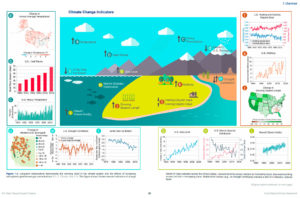
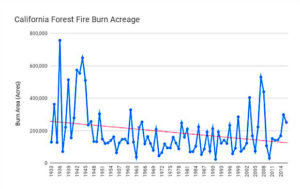

Gidday Tone
I enjoy your writing. I agree with what you say about much of the alarmist stuff from the environment movement. However…..
Somewhat to my surprise I have become deeply involved in fire management issues here in Oz. And from this space there ain’t no doubt that the threat of fire is getting more serious. Only today there was a detailed press release from twenty-three of Australia’s most senior former emergency service bosses who have come together in an unprecedented show of unity, calling on the Prime Minister to ‘get on with the job’ of reducing greenhouse gasses. See https://www.sbs.com.au/news/former-fire-chiefs-demand-urgent-action-on-escalating-climate-change-threat
These people are hard-bitten fire fighters, and they are scared about what is happening.
I used to say that the situation we were facing re climate change is a bit like being in a bus, it’s really foggy, we think there might be a cliff ahead, we think the brakes might work but we’re not sure -so do we push the pedal or not? But I don’t say that any more, because it isn’t foggy; there is so much good scientific evidence that there is a cliff ahead and we need to change course and we can do it..
Well yes, the ‘Population Bomb’ shows the perils of simple extrapolation. But what would be more instructive is examining why it turned out to be incorrect. Same for the new ice age is coming.
BTW I really enjoy your posts on the EU, so more please! 🙂
Comments on this entry are closed.